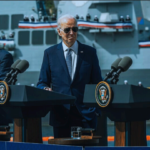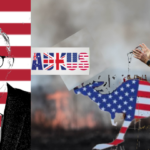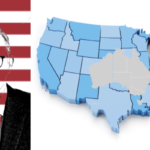With So Much Local US Military Presence, Can Australia Really Say No to a War on China?

The Pentagon announced in June 2025 that it’s conducting a review of the 2021-established AUKUS security arrangement, which at its heart involves our nation acquiring eight nuclear-powered submarines (SSN) with the assistance of pact partners the US and the UK, and whilst this continues, Washington has now upped the ante by requesting Australia commits to a US-led war on China.
Somewhat embarrassingly for the Australian prime minister, the Financial Times revealed on 12 July that US undersecretary of defence policy Elbridge Colby was requesting such a commitment in response a hypothetical suggestion that Beijing attempts to take Taiwan, as this coincided with the beginning of Anthony Albanese’s weeklong diplomatic tour of the East Asian giant.
When a reporter suggested it was perhaps unfair of Washington to require Canberra, along with Tokyo, to provide future commitment to a hypothetical war against Beijing, in response to any attempt to attack Taiwan, because the US exercises “strategic ambiguity” – or reserves such decisions to actual developments – Albanese agreed and said he’d be reserving his decision similarly.
But according to US defence secretary Pete Hegseth, the kick off to ‘the war to end all wars’ “could be imminent”. Hegseth suggested this while speaking at the Shangri-La Dialogue in Singapore last month, and he further announced on the next day that the event had afforded him an opportunity to press Australian defence minister Richard Marles on upping our defence spend to 3.5 percent of GDP.
Federal Labor recoiled at the news that the US is reviewing AUKUS. Yet, much of the local commentariat have embraced this, suggesting it’s a prime time to exit the deal. In fact, the recommendation is that Australia contemplates pulling out of its decadeslong arrangement with the US. Yet, this tends to suggest that our nation continues to have any say in how this all pans out.
“Achieving peace through strength”
As former Labor senator Doug Cameron put it, during a 13 July 2025 IPAN (Independent and Peaceful Australia Network) forum, Australia has followed the United States into over half a dozen wars including Vietnam, Iraq and Afghanistan, none of which it has won, so why would Washington consider it could take on the East Asian giant and win, and more to the point, why would we follow?
Colby has been pushing for a commitment from Australia and Japan to follow the US into war against China for a number of months now. So, the calling of the AUKUS review in June, which was widely read as a means to encourage this country to up its defence spending, as the US is recommending all of its allies to do, was likely further to help secure our commitment to a war on China.
The Financial Times outlined that Australia and Japan were surprised by the US request to pre-commit to a war against China because it doesn’t give out blank cheques itself. However, during his presidency Joe Biden breached this policy of never committing to conflict in advance on four separate occasions, outlining that if Beijing launched an attack on Taipei, Uncle Sam would be there.
But while Albanese might reserve any decision on China to practical situations when being quizzed in public, the concrete situation is that the United States has been building up its presence in the top end of this continent since 2011, and, as for Japan committing, well, it was announced late last year that Tokyo would commence having a regular troop presence in the Northern Territory.
Reviewing AUKUS
A vocal AUKUS “agnostic”, Colby was charged with reviewing the US, UK, Australia pact in June.
Critics of the arrangement have hailed this as an opportune time to reconsider it, as the eight Australian-owned SSN that were the centrepiece of the deal when then PM Scott Morrison unveiled it in late 2021, now seem increasingly unviable. But the pact involves more than just submarines, as there’s an immense amount of interoperability between the US and Australian forces these days.
A key issue regarding the subs is that none are supposed to show up until the 2030s, and this would involve the US initially selling us three Virginia class submarines early next decade, but the catch is the Pentagon needs to produce enough to meet its own needs prior to matching ours and production is way behind. The deal also involves UK assistance on five more SSN, which too seems unlikely.
However, in terms of an “imminent” war with China, in which SSN stationed in Australia would be advantageous, the US and the UK are establishing Submarine Rotational Force-West at HMAS Stirling, off the coast of Boorloo-Perth in Western Australia by 2027, and this involves four US SSN and one UK nuclear-powered boat rotating through a purpose-built base in the west of the continent.
So, regardless of whether the AUKUS submarine deal ever comes to fruition, the US will have boats stationed down under to war on China.
As part of the 2014 Force Posture Agreement, the US also has 2,500 Marines stationed close to Garramilla-Darwin, and as well, the American and Australian air forces are becoming increasingly interoperable and Washington has unimpeded access to a secret list of military bases and areas across this continent and when the US upgrades an Australian base, it takes complete control of it.
The scope of the US presence on this continent is currently unknown. The intelligence gathering base of Pine Gap in the centre of the continent and another installation at North West Cape were established in the 1960s and are of great strategic importance to Washington, and the US has been making inroads over here ever since, which has picked up a pace since its 2011 pivot to Asia.
Uncle Sam is us
If the US decided the AUKUS subs are no longer viable, it doesn’t mean that the US will be exiting this continent, it simply means that any locally stationed SSN will belong to them or London. And regardless of whether Canberra conducts its own AUKUS review and decides to dump the idea of SSN ownership as a way forward, it’s likely the rotating US SSN will still be stationed off the coast in WA.
The United States is now regularly refuelling its jets, such as the B-2s, over Australia as they fly them from Whiteman Air Force base in the US state of Missouri on their way to the Middle East, whether that be for active combat or otherwise.
So, perhaps Elbridge Colby should rephrase the question when putting it to this nation, so it’s easier to grasp, and what it likely should read is something along the lines of: “When we launch a war against China from the continent of Australia, will Australia be joining us?”







